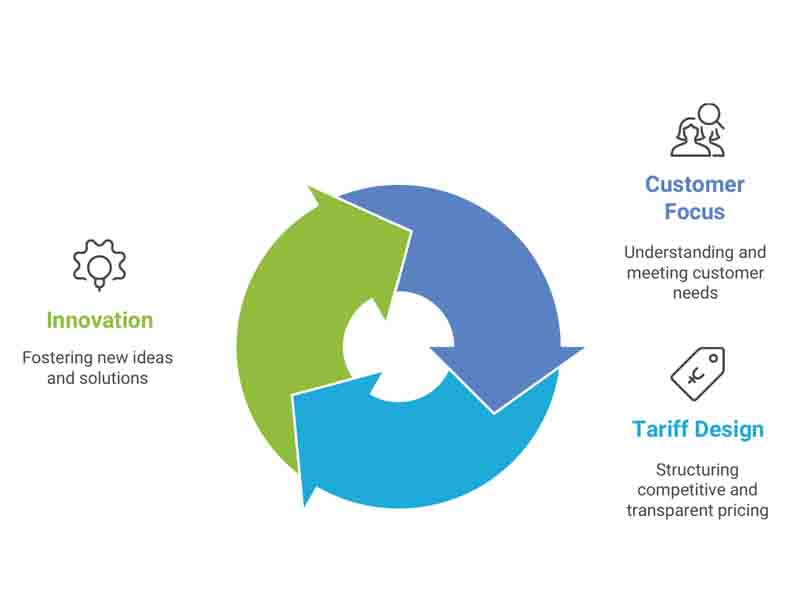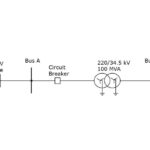
In last two decades of my professional life, I have worked in almost all types of competitive environment in Retail Electricity Supply Scenario. I started my career in a Power DISCOM in Greater Noida, having monopoly in its area of supply by virtue of single supplier. Subsequently, I moved to one of the Mumbai DISCOMS, wherein two distribution licensees operated in the common area of supply by using each other’s networks, i.e., a form of Duopoly. Going forward, I also worked in a power DISCOM in West Bengal, wherein multiple, precisely three DISCOMs, supply power to a common area of supply connected to different respective networks, i.e., a form of Oligopoly.
In the rapidly evolving landscape of India’s power sector, the shift towards a competitive retail electricity supply market marks a pivotal transformation. Gone are the days of monolithic utilities dictating terms; today, consumers wield unprecedented choice, empowered by regulatory reforms like the Electricity (Rights of Consumers) Rules, 2020, and the push for open access. As a seasoned professional in the power industry, I have witnessed firsthand how this competition fosters innovation but also intensifies the battle for customer loyalty. Retail electricity suppliers must now pivot from mere service providers to strategic partners in energy management. At the heart of this evolution lie three foundational themes: Customer Focus, Tariff Design, and Innovation. These pillars not only enhance engagement but also drive sustainable growth in a market projected to reach $200 billion by 2030, according to industry estimates.
Drawing from my experience of working in various Power DISCOMS across competitive markets, I argue that mastering these themes is essential for suppliers to thrive amid rising competition from private players, renewable energy integrators, and digital disruptors. This article delves into each theme, offering actionable insights tailored to India’s unique context – where urban electrification meets rural aspirations, and sustainability intersects with affordability. By weaving these strategies into their operations, suppliers can transform passive consumers into active advocates, fostering a resilient ecosystem that benefits all stakeholders.

Embracing Customer Focus:
The Bedrock of Loyalty
Customer focus isn’t just a buzzword; it’s the cornerstone of any successful engagement strategy in the retail electricity market. In India, where over 300 million households rely on electricity for daily life, understanding diverse consumer needs is paramount. Urban professionals in Mumbai or Bengaluru demand seamless digital interfaces, while rural farmers in Uttar Pradesh prioritise reliability during peak irrigation seasons. Suppliers must segment their audience meticulously, leveraging data analytics to personalie experiences.
Consider the power of empathy-driven engagement. My tenure in developing strategies for leading power discoms revealed that proactive communication bridges trust gaps. For instance, during the 2023 summer blackouts in northern India, suppliers who sent real-time alerts via SMS and apps about load shedding schedules retained 20-30% more customers than those who didn’t, based on anecdotal industry reports. Implementing customer relationship management (CRM) systems allows for tailored outreach, such as energy-saving tips for high-usage households or bill payment reminders for low-income segments.
Loyalty programs further amplify this focus. Drawing parallels from competitive markets like Texas or the UK, Indian suppliers could introduce reward schemes where consistent on-time payments earn points redeemable for discounts on appliances or solar installations. In a country grappling with energy poverty, such initiatives resonate deeply. Suppliers should invest in feedback loops, like post-service surveys or community forums, to iterate on offerings. This human-centric approach turns customers into co-creators, reducing churn rates that currently hover around 15-20% in competitive pockets.
Moreover, inclusivity is key in India’s diverse demography. Strategies must address gender dynamics, empowering women through educational webinars on energy efficiency or cater to senior citizens with simplified billing. By prioritising accessibility, such as multilingual support and voice-assisted apps, suppliers can engage underserved segments, aligning with the government’s ‘Power for All’ vision. Ultimately, customer focus cultivates emotional loyalty, where consumers choose suppliers not just for price, but for perceived value and partnership.
Innovating Tariff Design: Balancing Affordability and Flexibility
Tariff design is where art meets science in customer engagement. In India’s retail market, where subsidies and cross-subsidies distort pricing, innovative tariffs can differentiate suppliers and encourage efficient consumption. Traditional flat-rate structures are outdated; dynamic pricing models, inspired by global best practices, hold immense potential here.
Time-of-Use (ToU) tariffs exemplify this shift. By charging lower rates during off-peak hours (e.g., midnight to 6 AM), suppliers incentivise load shifting, easing grid strain during evenings when demand spikes due to air conditioning and EV charging. In Delhi, where peak demand often exceeds 7,000 MW, ToU adoption could reduce bills by 10-15% for compliant users, fostering engagement through tangible savings. My experience in tariff consultations highlights the need for transparency: suppliers must educate consumers via infographics or demo apps to demystify these models, preventing bill shock.
Green tariffs add another layer of appeal, tapping into India’s renewable ambitions under the National Solar Mission. Offering ‘100% green’ plans at a premium, sourced from solar or wind, engages environmentally conscious millennials in cities like Hyderabad. Bundling these with carbon footprint trackers enhances perceived value, aligning with the country’s net-zero goals by 2070. For industrial consumers, who account for 40% of electricity demand, demand-response tariffs reward curtailing usage during peaks, potentially saving crores annually.
Prepaid metering, already prevalent in states like West Bengal, revolutionises engagement by giving control back to consumers. Like mobile recharges, users top up accounts, avoiding disconnection surprises and promoting budgeting. Integrating this with smart meters, rolled out under the Smart Meter National Programme, enables real-time monitoring, turning tariffs into interactive tools. However, challenges like digital literacy must be addressed through grassroots campaigns.
Innovative designs also mitigate affordability concerns. Tiered tariffs, where basic consumption is subsidised and excess is premium-priced, ensure equity. Suppliers can partner with fintech for instalment plans or integrate with UPI for seamless payments, reducing barriers. In competitive markets, those who design tariffs as customer-centric solutions, not impositions, see higher adoption. By innovating here, suppliers not only engage but also contribute to grid stability and energy equity.
Driving Innovation: Technology as the Engagement Catalyst
Innovation propels customer engagement into the digital age, leveraging India’s tech-savvy population and burgeoning startup ecosystem. With over 800 million internet users, the retail electricity market is ripe for disruption through AI, IoT, and blockchain.
Smart home integrations stand out. Suppliers can develop apps that connect with IoT devices, allowing users to automate appliances for optimal energy use. Imagine a Bengaluru resident’s AC adjusting based on real-time pricing signals, saving energy and costs. Innovators like Schneider Electric underscores the ROI: such systems can cut household consumption by 15-20%, with gamification elements (e.g., badges for efficiency) boosting user interaction.
AI-powered chatbots and virtual assistants enhance service delivery. In a market plagued by query backlogs, 24/7 bots handling complaints or usage queries free human agents for complex issues. Adani Electricity’s AI-driven platform in Maharashtra exemplifies this, resolving 70% of inquiries instantly and improving response times.
Blockchain for transparent billing addresses trust deficits, especially in disputed areas. By recording transactions immutably, suppliers reduce fraud allegations, common in India’s litigious environment. Peer-to-Peer (P2P) energy trading, enabled by blockchain, lets prosumers (e.g., rooftop solar owners) sell excess power directly, engaging communities in micro-grids. Pilots in Tamil Nadu show promise, empowering rural cooperatives.
Sustainability innovations like Virtual Power Plants (VPPs) aggregate distributed resources, EVs, batteries, for grid support, rewarding participants with credits. In urban hubs, AR/VR tools for virtual energy tours educate consumers, making abstract concepts tangible.
Yet, innovation must be inclusive. Bridging the digital divide requires offline options, like USSD codes for feature phones, and cybersecurity measures to protect data. Collaborations with startups under the Atal Innovation Mission can accelerate adoption. Suppliers investing in R&D hubs, as seen with NTPC’s ventures, position themselves as leaders.
Charting the Path Forward
In conclusion, the competitive retail electricity supply market in India demands a paradigm shift towards holistic customer engagement. By centering strategies on Customer Focus, Tariff Design, and Innovation, suppliers can navigate challenges like regulatory flux and competition from renewables. This trifecta not only boosts retention, potentially increasing market share by 10-15%, but also aligns with national imperatives of affordability, sustainability, and digitalisation.
As we approach the 2030 Sustainable Development Goals, the onus is on industry leaders to act decisively. Policymakers should facilitate through incentives, while suppliers pilot these strategies in phased rollouts. From my vantage point, the future belongs to those who view customers as partners in India’s energy transition. Embrace these themes, and watch engagement soar, powering a brighter, more equitable tomorrow.

Karn Pallav is a qualified Mechanical Engineer and MBA (Power) graduate from NPTI Faridabad. He is currently working as Head (Regulatory Affairs) in a leading power DISCOM at New Delhi. He has around two decades of management experience in the entire value chain of the Power Sector. He has vast experience in power utilities dealing with competition issues, tariff determination, licensing and other techno-commercial matters. Being an engineer and Power Manager, he is also interested in technical issues related to Conventional and Renewable Generation, Open Access, parallel license regime, Smart grid, AMI, Smart meters, Cyber-security issues and E-mobility. He has also written five books, namely: 1) The Power of Positive Thinking, 2) Customer Engagement Strategies in Retail Electricity Market, 3) 5 Rules for Life, 4) Whispers of the Heart and 5) Whispers of the Himalayas.



















